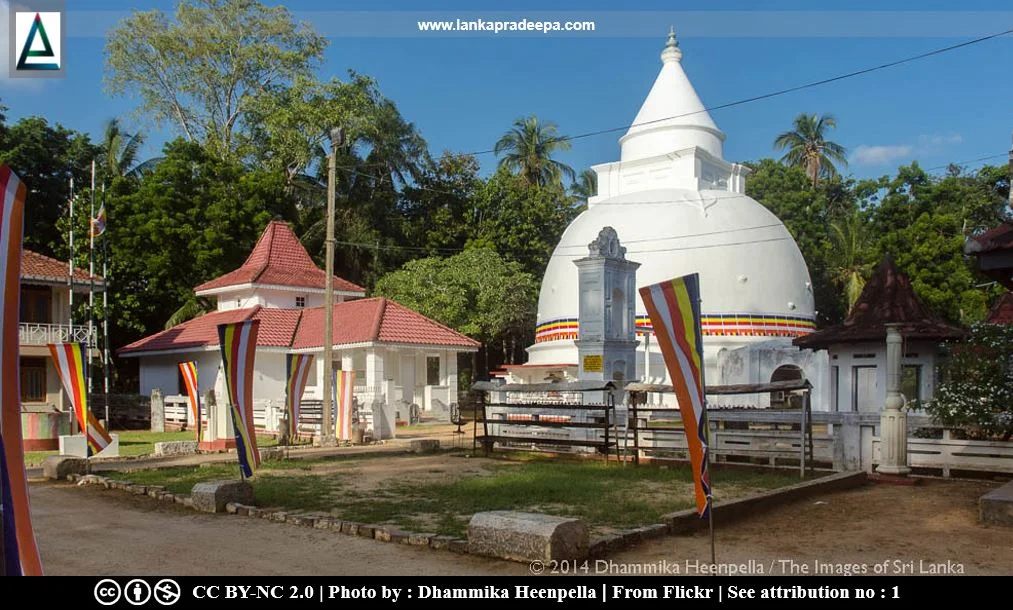
Girihandu Viharaya or Girihandu Vehera (Sinhala: අම්බලන්තොට ගිරිහඬු විහාරය) is a Buddhist temple situated on the bank of Walawe Ganga river in Ambalantota in Hambantota District, Sri Lanka.
History
Although written sources do not provide information on Girihandu Viharaya, it is believed that this temple was constructed during the Anuradhapura Period (Abeyawardana, 2004). Excavations carried out at this site unearthed a large number of artefacts and monuments belonging to the 5th-8th centuries A.D. (see the below "Excavations & findings" part). Due to the discovery of several Bodhisattva statues, it is thought that this temple was under the influence of Mahayana Buddhism (Abeyawardana, 2004).
The hair-relic of the Buddha
Pujavaliya, a chronicle of the 13th century A.D., records that two sea-faring merchants named Tapassu and Bhalluka erected a Stupa at Girihandu in Sri Lanka by enshrining the hair-relics of the Buddha (Paranavitana, 1934). Due to the similarity of the name, some people in Ambalantota tended to believe that the hair relic brought by these two merchants was enshrined in the ancient Stupa of this temple (Paranavitana, 1934). However, the Girihandu Stupa which is mentioned in Pujavaliya has been identified with the present Girihanduseya Stupa at Thiriyaya in Trincomalee District (Paranavitana, 1934).
Separation of the temple land
The Kataragama-Tangalle main road (A2) that was constructed in the early
20th century divided the original temple land into two parts
(Abeyawardana, 2004; Roth et al, 2001). The part on the northern side was reserved for the temple and the other part (southern side) located opposite side of the road was occupied by a rest-house. However, many remains of ancient structures were discovered during the
inspections carried out in the rest-house premises in the 1950s
(CYB, 1959). From 1964-1965, the rest-house was used as an archaeological museum for the Hambantota area and in 1995, it was converted into a cultural centre (Roth et al, 2001).
Excavations & findings
ExcavationsExcavations were carried out at the temple premises by R. Silva in the 1960s (Roth et al, 2001). In 1964/65, the Department of Archaeology excavated the backyard of the rest-house (Roth et al, 2001). The site was again excavated in 1997-1999 by the Department of Archaeology together with a German archaeological team (Roth et al, 2001).
Findings
Many artefacts that belonged to the ancient Buddhist monastery have been found on the temple premises (Abeyawardana, 2004). A limestone plaque containing a sculpture, in the Amaravati style,
depicting the renunciation of Prince Siddhartha was discovered in 1870
during the restoration work on the Stupa (Paranavitana, 1934; Roth et al, 2001; Somadeva, 2006). The plaque is believed to have been imported
from the Andhra region in India (Ray, 1959; Somadeva, 2006). It has been dated by scholars to the 5th-6th centuries A.D. (Roth et al, 2001).
Other notable findings include a small bronze statuette depicting two antithetically positioned lions connected with their flanks, a colossal 7th-8th century A.D. image of the Buddha (3.15 m), an Avalokitesvara head (0.57 m) and torso (0.86 m), a Bodhisattva torso (1.12 m), a dismembered pair of feet (0.6 m), and a Roman coin [(335 A.D.) Roth et al, 2001]. These artefacts have been dated by scholars to the 7th century A.D. or to the late Anuradhapura Period (Roth et al, 2001).
Excavations done on the site between 1997-1999 exposed many brick and stone structures including a circular building probably a relic house (Roth et al, 2001).

.
Attribution
#) LankaPradeepa.com extends its gratitude to Lalith Kekulthotuwage for providing the necessary photographs required for this article. All the photos are published here with the permission of the author.
References
1) Abeyawardana, H.A.P., 2004. Heritage of Ruhuna: Major natural,
cultural and historic sites. Colombo: The Central Bank of Sri Lanka.
ISBN: 955-575-073-4. p.120.
2) CYB, 1959. Ceylon Year Book. Department of Census and Statistics. Colombo. p.213.
3) Paranavitana, S., 1934. (Edited and translated by Codrington, H.W.; Paranavitana, S.) Tiriyay rock-inscription.
Epigraphia Zeylanica: Being lithic and other inscriptions of Ceylon:
Vol. IV. Archaeological Survey of Ceylon. pp.151-160.
4) Ray, H. C. (Editor in Chief), 1959. University of Ceylon: History of
Ceylon (Vol 1, part I). Ceylon University Press. p.403.
5) Roth, H., Steinbring, B., Wijeyapala, W., 2001. Archaeological investigations at the Girihandu Vihara, Ambalantota (Hambantota District). Ancient Ruhuna, Sri Lankan–German Archaeological Project in the Southern Province. Vol:1. pp.294,349-356.
6) Somadeva, R., 2006. Urban origins in southern Sri Lanka. Doctoral thesis in archaeology at Uppsala University. p.60.
Location Map
This page was last updated on 26 November 2023

